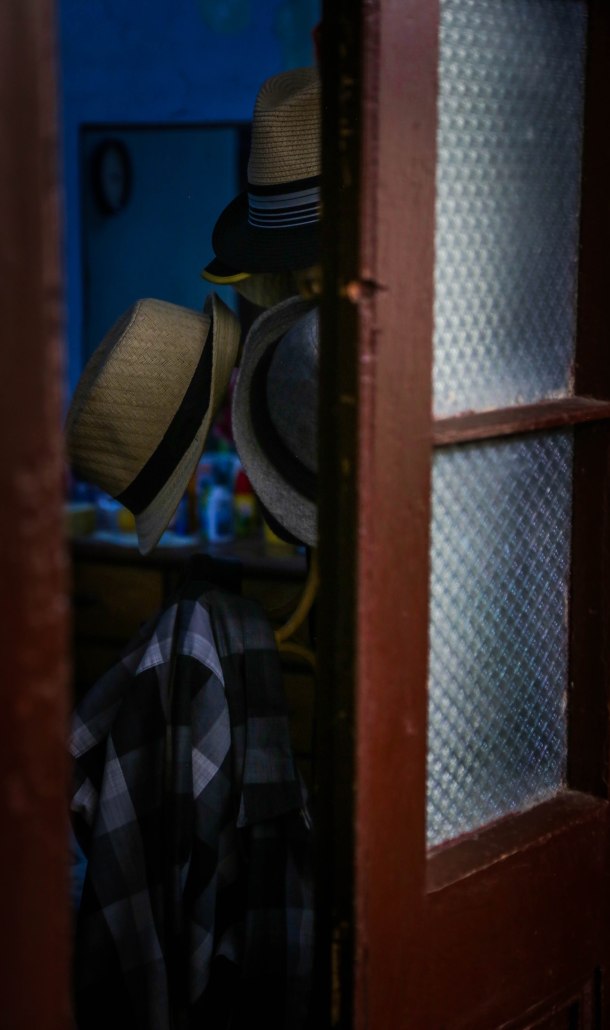
Soft yellow walls, painted against the dark red wood of tall windows and door frames, offer a warm welcome to Havana, Cuba. This naturally sunny color could be oppressive, in the 88 degree heat – the bedroom I slept in for a while as a teen was a more vibrant yellow, hot and smothering – but high ceilings pull the heat of the day up and away, through windows that reach almost to the top. The classic building, more than 90 years old, has the same high ceilings, the same welcoming feel, throughout the home.
We’ve rented a simple room with a bed, a couple of high-backed, wicker rocking chairs and a pair of nightstands strewn with tourist guides. There is a guest book, labeled “Book 1”, that is completely full of stories, half of which I cannot read. They are in Spanish, German, French . . . evidence of the wide range of guests who have stayed here. A worn and market map of Havana is nailed to the far wall, and this is what our host uses to show us how conveniently located his home is – to the monuments, museums, cathedrals, shops and restaurants of Old Havana.
On the opposite side of the room is an English language wall calendar, featuring destinations from around the world – it’s “1,000 Places to See Before Your Die: A Traveler’s Calendar”. I’m in the right place, for sure! The back of the calendar reads: “Follow Your Wanderlust”. I will!
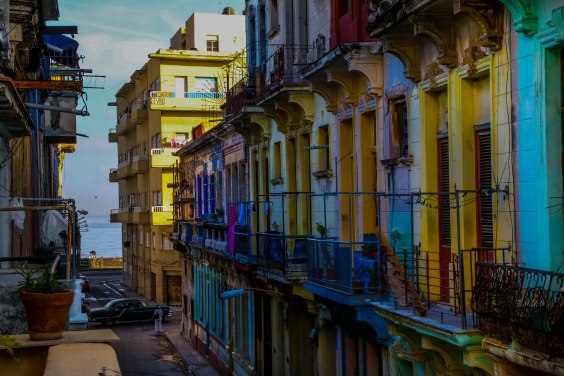
The room was booked through Airbnb, which I’m experiencing for the first time. It’s a different concept, a unique way to travel. The service’s website declares: “Unforgettable trips start with Airbnb. Find adventures nearby or in faraway places and access unique homes, experiences, and places around the world.” (see link) Upon check-in, after producing passports for identification, the owner hands over a full ring of keys. We’re invited to make ourselves at home. We’re presented with 5 keys, as if we might be staying longer than the 24 hours that are planned:
Key # 1: The first key gains access into the old red & yellow building, unlocking a heavy, wooden door. I’m greeted by two flights of stone stairs, polished by years of wear, and surrounded by metal railings and gates.
Key # 2: At the top of the first flight of stairs, on a small landing, the second key is used to open a metal gate that separates the host family’s dwelling from the rest of the building.
Key # 3: Up a second flight of stairs, the third key turns once, twice, three times, gradually pushing a bolt out of the way, to allow entry. This is not a quiet process, especially when you don’t know how this type of deadbolt lock works.
Key # 4: My room is behind a final, locked, door. To reach it, I travel through the living room, past the owner’s bedroom, then down a corridor that is open to the blue sky & hot, humid air. Sweeping my gaze around the room, the first item I search for is an air conditioner. There it is!
Key # 5: At this point I’ve lost track of what the final key was for, but I feel rather safe (not trapped) behind all these barriers.
The building itself is on the corner of the street, pressed against the neighboring building, which stands in close quarters with the next, and then the next. There hadn’t been a lot of room for the airport taxi to pull over and let us out. Streets are narrow. There are sidewalks; no one is using them. Local residents choose instead to walk casually, and without visible concern, down the middle of the street. The road is shared by cars, motorcycles, bicycles, carts, pedestrians and feral cats and dogs, searching for any sort of handout. The cab driver waits long enough to make sure that the owner is home, and we have access to the residence.
We meet our host, Alvio. He and his daughter, a certified teacher and owner of a shop that sells her handicrafts, work together to book travelers in their spare room. Alvio makes an effort to communicate in English, as he gives a tour. The room next to ours is occupied by . . . (what is the word??) . . .his Grandson? Yes, his grandson! We bump into this teenage grandson late that night, after our adventures wandering the streets of Old Havana.
It’s not until the next morning that I realize there are more accommodations on the floor above us, accessed by a spiral staircase, crafted from the same metal that the railings and gates are made of. At breakfast we meet a pair of fellow travelers who arrived from California, late the night before. They spent their first night on the upper floor. It’s their first time in Cuba, and they are asking us for advice. “When did you arrive?” Yesterday. “Oh, okay. How long are you staying?” We leave this afternoon.
We swap travel stories, including talk of visits to California, use of Airbnb, international travel and what are expectations for Cuba are. It’s a casual, relaxed atmosphere. We take our time with the meal.
The $5 breakfast is optional, but we accept it eagerly, curious about what a local Cuban will offer his guests. We are glad that we did, for the time spent with this family, as well as for the food. A bowl of fresh papaya, pineapple, guava, mango, and banana starts the meal. Alvio’s daughter puts in a brief appearance, extending another warm welcome to her Country. I’m served fried eggs, and toast with cheese and fresh butter, alongside guava juice and Cuban coffee.
Oh, the coffee! Our gracious host cautions us that Cuban coffee is very different than what we might be used to; it’s a lot stronger, more like espresso. We pour it into tiny glasses, and he points out all variety of sweeteners and creamers, in case we can’t tolerate what’s in our cups. I’m in heaven, as I breathe in the aroma of my small, black cup of coffee. I’m anticipating quite a jolt from the caffeine. There have been numerous requests for me to bring back coffee for friends. I plan to purchase some beans, if I can track some down, and ask Alvio for a recommendation . . .but that’s a story for another day.
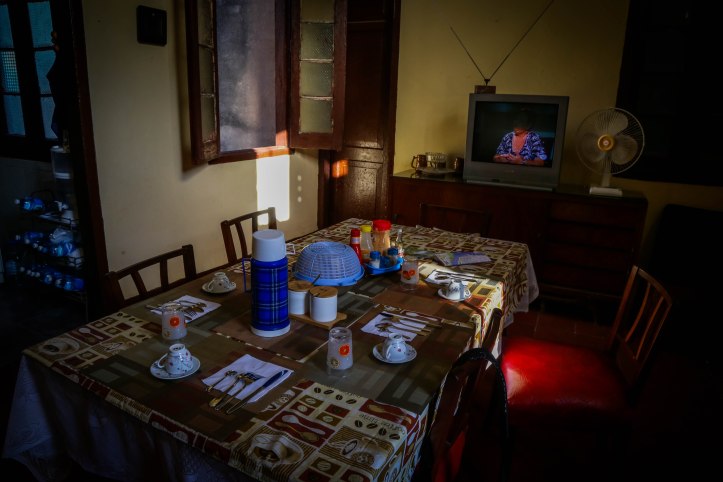
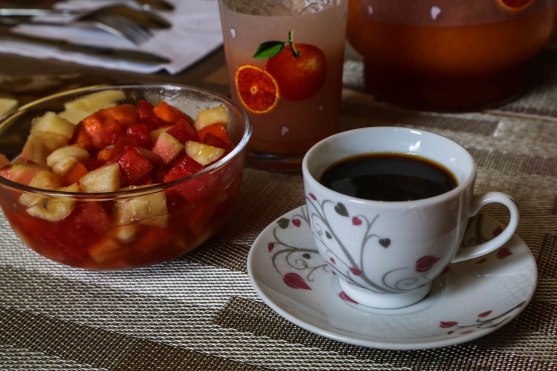
The TV is on in the dining room. It broadcasts an English language program, and we watch while our hosts prepare our meal. The program is teaching basic English words like “cap” and “skirt”, putting them in the context of items you might wear to the beach. Alvio is fully engaged with the program. When the “teacher” on the screen says “Repeat after me. . .” he does, every time! A young woman is helping him prepare our breakfast. She sighs a little, folding her arms across her chest and leaning in the doorframe. “She doesn’t like English,” our host tells us. He nudges her, prodding her to join in the lesson.
My command of the Spanish language isn’t great, yet I’ve been to Costa Rica, Mexico and now Cuba in 2016. The tourism industry thrives on American travelers, so there is a strong incentive to learn English. I was a bit nervous, however, because Cuba is so recently becoming more open to tourism. In fact, that was an important reason for visiting now, before there is a McDonald’s or Starbucks on every block. I was trusting in the kindness of the locals, my broken Spanish, and a bit of occasional sign language.
I’m grateful for the opportunity to be here, and worry that the political climate may close off entrance into, or commerce with, the country. For now, I soak in the culture and the architecture, feeling very much at ease in this company. All of the buildings in this part of town have balconies, and there is an expansive view of bright colors, noisy commuters, and general chaos in the streets. North from the front balcony you will catch a glimpse of the Straits of Florida, connecting the Gulf of Mexico and the Atlantic Ocean. Locals go about their day, without much concern for us tourists.
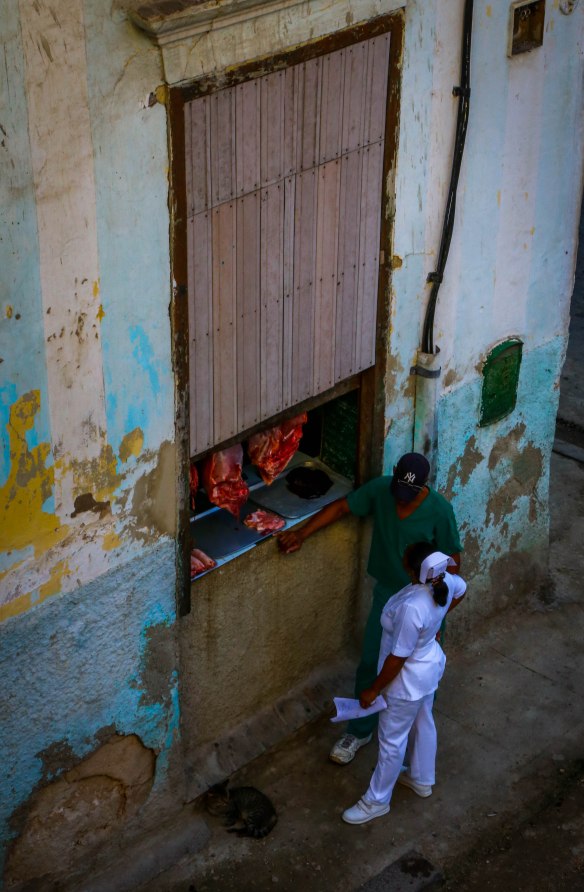
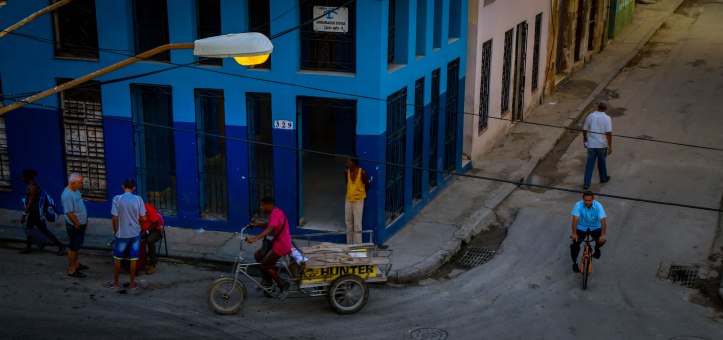
We ask our host what he’d recommend we do, with just 24 hours on the ground, and without a car. He doesn’t hesitate; he directs us to explore the older part of town. He cautions us that it’s not necessary to accept a ride from one of the many cabs honking at pedestrians on the busy streets. There are modern taxis, but the streets are dominated by relics from the 30s, 40s & 50s. A bright red Chevy Bel Air pulls up alongside a pink Cadillac, while a baby blue Ford and a green Pontiac move in the opposite direction. Most are in mint condition, obviously demanding a great deal of care and attention over the years. It feels a little like we’ve stepped back in time.
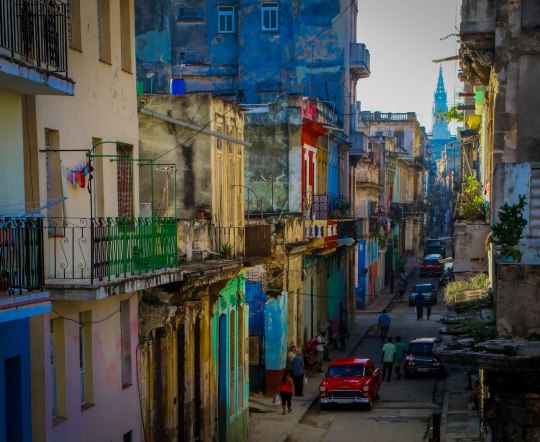
I’m still adjusting to the 50 degree change in temperature, from the 30 degree conditions I woke up to that morning, back home. So I change into my lightest clothing and a pair of Keen sandals. I’m ready to set out on foot, with my camera in hand . . .
. . . to be continued.
Join me on my next adventure,
~ Kat
Related Links:
Airbnb Cuba: https://www.airbnb.com/wishlists/welcome-to-cuba
Map of Cuba: http://www.mapsofworld.com/cuba/





Can’t wait for part 2. What lovely colors you experienced…visually and culturally.
Blog On.
LikeLike
Excellent post and great photos. I’ll have to reblog. Looking forward to your other posts.
LikeLike